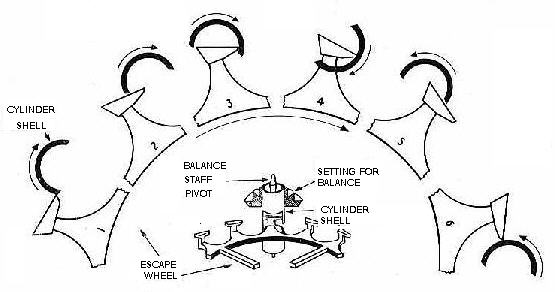
CYLINDER ESCAPEMENT. See Pl. 126 and Fig. I. The escape wheel teeth in this escapement, unlike the
verge, lie in a horizontal plane, and when it was introduced by George Graham in 1726 it was known as the
'horizontal escapement'. The escape wheel usually has fifteen wedge-shaped teeth, standing above the rim of the
wheel, the pointed end of the 'wedge' leading. Mounted on the balance staff is a polished steel tube or hollow
cylinder - which gives

the escapement its name - nearly one half of which is cut away allowing the teeth to enter as the balance swings
back and forth and the wheel rotates. As each tooth enters the cylinder it impulses the balance on the entry lip of
the cylinder wall. The tooth rests within the cylinder while the balance completes its oscillation (the 'supplementary
arc') and begins its return journey. In due course the tooth escapes from within the cylinder, again giving impulse
as it leaves. The succeeding tooth, which has been held against the outside wall of the cylinder while the first is
within and the balance is making its excursion and return, now enters the cylinder, and the process is repeated.
The diagram (Fig. I) shows the cycle of operation. Position 1 shows a tooth the instant before it enters the cylinder.
2 shows a tooth entering and giving impulse by sliding motion. At 3, the tooth has dropped on to the inner wall and
the escape wheel is locked while the balance completes its excursion and begins its return journey, as seen in 4. 5
shows the position reached when the tooth escapes from the cylinder giving impulse as it does so to the balance in
its back swing. Immediately it does escape, the next tooth following drops on to the outer wall of the cylinder, as
seen in 6. As there is no 'recoil' (q.v.), the escapement is a 'dead-beat' type. It is also classed as a 'frictional rest'
escapement as opposed to a 'detached' one (q.v.). See also RUBY CYLINDER and CYLINDER PLUGS.

126. Cylinder escape wheek, arbor and pinion. Balance spring and cylinder. Also showing cylinder plug, banking pin, and lower pivot. These
parts are from a movement by Thomas Mudge. Circa 1750.
CYLINDER PLUGS. Plugs fitted into the top and bottom of the cylinder, the ends of which form the pivots for
the balance staff.